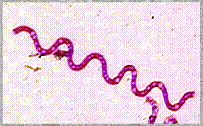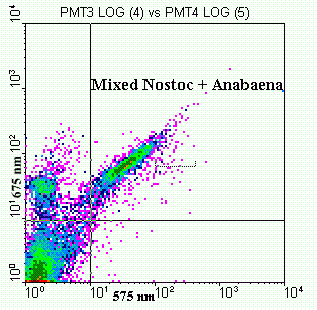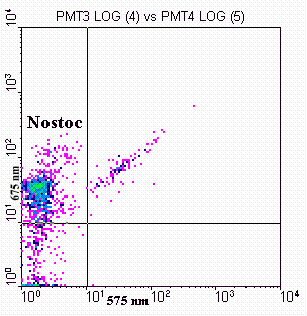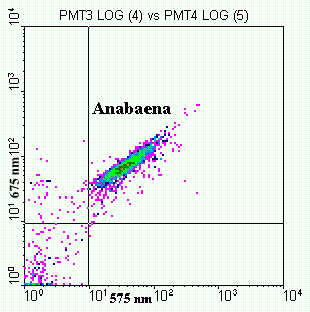

Flow Cytometry and Microbiology

Autofluorescence of cyanobacteria.
Jaume Comas-Riu
Servei Cientifico-Tecnics
University of Barcelona
c/ Lluis Sole I Sabaris, 1-3
08028 Barcelona, Spain
 email: jaume@giga.sct.ub.es
email: jaume@giga.sct.ub.es
Florencio Carretero
Izasa, S.A.
Arago, 90.
08015 Barcelona, Spain
 email: fcarretero@spain.ilww.com
email: fcarretero@spain.ilww.com
Data Examples
The autofluorescence of a mixture of two cyanobacteria was analyzed using the Coulter EPICS ELITE flow
cytometer. The mixture included long filaments of Nostoc and Anabaena. Fluorescence resulting from excitation
with the 488 nm laser (15 mW) was collected using a 575 nm BP filter (PMT3) and a 675 nm BP filter (PMT4).
The 575 nm fluorescence was associated with carothenoid pigments while the 675 nm fluorescence was due to
chlorophyll. Using autofluorescence, the two populations in the mixture were distinguished (Figure 1) and
sorted (Figure 2 and Figure 3).

Figure 1. Using autofluorescence, the two populations of Cyanobacteria could be distinguished.

Figure 2. Nostoc sorted from the cyanobacteria mixture.

Figure 3. Anabaena sorted from the cyanobacteria mixture.
 Back to Flow Cytometry and Microbiology Introductory Page
Back to Flow Cytometry and Microbiology Introductory Page
CD ROM Vol 2 was produced by staff at the Purdue University Cytometry Laboratories
and distributed free of charge as an educational service to the cytometry community.
If you have any comments please direct them to
Dr. J. Paul Robinson, Professor & Director, PUCL, Purdue University, West Lafayette,
IN 47907. Phone:(317) 494-0757; FAX (317) 494-0517; Web http://www.cyto.purdue.edu EMAIL robinson@flowcyt.cyto.purdue.edu




 email: jaume@giga.sct.ub.es
email: jaume@giga.sct.ub.es  email: fcarretero@spain.ilww.com
email: fcarretero@spain.ilww.com


 Back to Flow Cytometry and Microbiology Introductory Page
Back to Flow Cytometry and Microbiology Introductory Page 


